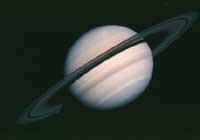The wind in Saturn is variable

The wind of Saturn and Jupiter is special. Unlike other planets, it moves to the east, and although there is much less radiation from the Sun than to the Earth, it is ten times stronger than those here. On Earth, the wind is governed by that radiation coming from the Sun, but on those distant planets there is thought to be another source of energy, although astrophysicists do not know what it is.
According to some theories, the wind is produced by the heat of the center of the planet. Keep in mind that Jupiter and Saturn are gaseous planets and do not have a surface like ours. Other theories argue that the wind comes from the fine skin of the high atmosphere and, as happens on Earth, is governed by solar radiation. These two options are difficult to check and, in any case, neither one nor the other properly illuminates the east-west game that performs the wind or the strong winds of Jupiter and Saturn, always in the east direction.

This group of astrophysicists from the UPV-EHU and another from the Wellesley College of Massachusetts have analyzed the images obtained by the Hubble Telescope to understand the behavior of the wind in Saturn. And they have made an unexpected discovery: In the period 1996-2002 it is observed that the speed of the equatorial wind has been half that recorded in the years 1980-81. Researchers Agustín Sanchez-Lavega, Santiago Perez-Hoyos, Jose Felix Rojas and Ricardo West participated in the study. Precisely in December 2002 we published the interview with researcher Sanchez-Lavega in the magazine Elhuyar Zientzia eta Teknika. In that interview Nature told us that in 1991 they offered him the skin for the work done around Saturn.
The wind speed was considered to be stable
The wind speed in Jupiter and Saturn was measured for the first time by Voyager ships in the early 1980s. Since then it has been concluded that the wind of Jupiter is persistent, but it was not very clear what happens in Saturn. Now, thanks to the work of UPV researchers, they have found that it has changed in the equator, but why? That is, is it changing in itself or has any special phenomenon occurred since the 1980s?

Saturn has several particularities with respect to Jupiter. The turning axis is lying, like the Earth, and the seasons remain long. In addition, its large annular system makes periodic shade to the equator, preventing in brief moments the solar radiation arrives. These particularities can make the wind in Saturn, at least in the equator, variable.
On the other hand, in Saturn, the most giant storms, unlike other planets, take place in the equator. In the years 1990-94 there were several and according to the researchers, perhaps that has calmed the wind. Or it is possible that in the period 1996-2002 higher clouds have been adopted to make measurements and that the air currents at that height are cheaper. In any case, the astrophysicists of the UPV-EHU have come to the conclusion that the wind occurs in the high atmosphere.
To prove this, it will be of great use the spacecraft Cassini-Huygens that will arrive to Saturn in 2004. This mission of the European and American space agencies will take high-resolution images and, perhaps, it will be then when all the mysteries of the wind are discovered in Saturn.
Buletina
Bidali zure helbide elektronikoa eta jaso asteroko buletina zure sarrera-ontzian











